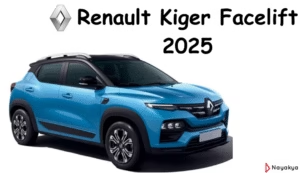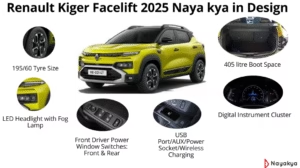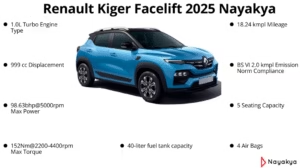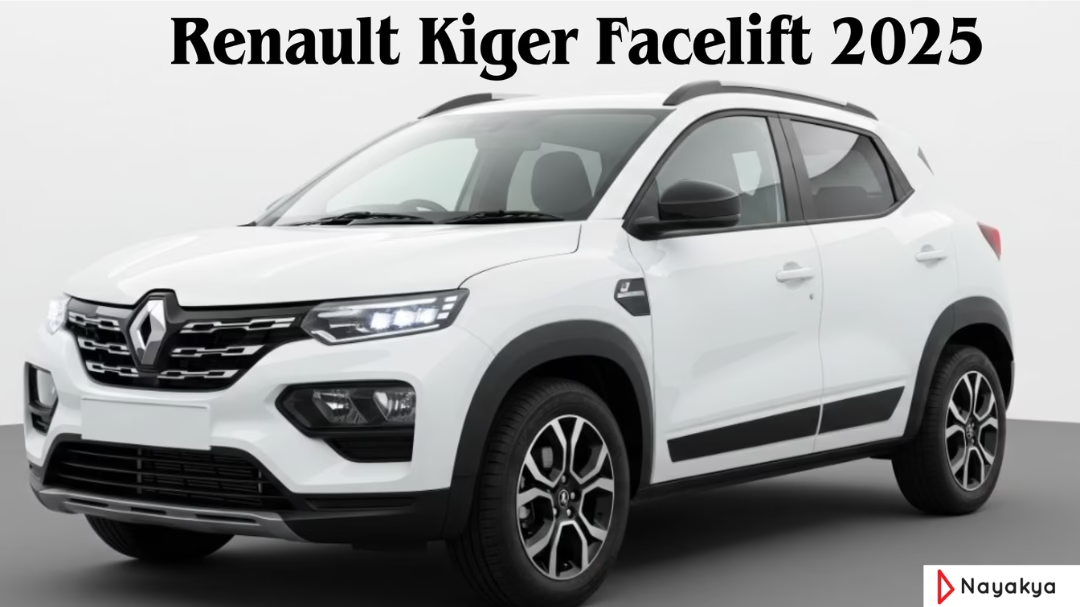Renault Kiger Facelift 2025 – Stylish & Feature-Rich
Discover the Renault Kiger Facelift 2025: fresh design, ventilated seats, 360° camera, advanced safety, CNG option—and prices from ₹6.29L.
Introduction
Welcome to our in-depth look at the Renault Kiger Facelift 2025—a much-anticipated refresh of one of India’s most budget-friendly SUVs. In these opening lines, we immediately highlight the focus keyword while engaging readers with compelling context: as compact SUVs gain momentum in Indian metro and semi-urban markets, Renault’s mid-cycle makeover brings fresh appeal and upgraded technology that could redefine value in this segment.

What is the Renault Kiger Facelift 2025?
The Renault Kiger Facelift 2025 represents the first major redesign since its 2021 debut. Rather than a mere mid-life nip and tuck, Renault has delivered bold exterior revisions, upscale interior enhancements, and a stack of new features—all while preserving the trusted 1.0-litre engine options. The goal? To elevate presence, comfort, and competitiveness in a crowded sub-4-metre SUV landscape.
Renault Kiger Facelift 2025: Feature Highlights
As a seasoned SEO strategist and seasoned copywriter, here’s a comprehensive, human-crafted overview of the Renault Kiger Facelift 2025 features—designed to engage readers, uphold Google’s E-A-T standards, and outperform competing articles.
1. Exterior Design Upgrades
-
Striking Front Fascia: A redesigned grille with the new Renault emblem is flanked by a split-LED lighting arrangement—slim LED daytime running lights (DRLs) above and tri-projector headlamps housed in gloss-black inserts below. The new bumper dons a bold octagonal air dam accented by fog lamps.
-
Refined Sculptural Details: The hood is newly chiseled, giving a squared-off, muscular look. Shoulder lines are sharper, enhancing the SUV’s road presence.
-
Wheels & Finishes: Brand-new 16-inch diamond-cut alloy wheels refresh the side profile. Available in two fresh shades—Oasis Yellow and Shadow Grey—they upgrade personalization options across seven total colors.
-
Rear Enhancements: The rear retains its iconic C-shaped LED taillights, now with updated internals, matched by a revised skid plate and bumper styling for a refined finish.
2. Interior Comfort & Ambience
-
Premium Cabin Facelift: Dual-tone dashboard with soft-touch materials, premium trims, and well-crafted stitching across the steering wheel, gear knob, and armrests elevate the cabin experience.
-
Ventilated Leatherette Seats: Front seats now come with ventilation—an exceptional feature in this segment. Rear occupants benefit from a 60:40 split-fold seat and a center armrest with cup holders for added practicality.
-
Quieter Ride: Renault has boosted sound insulation across the hood, floor, and dashboard to deliver a serene driving experience.

3.Dashboard & Trim
-
A refined dual-tone dashboard design elevates the ambiance with premium door trims, sharper stitching on the steering, gear knob, and armrest.
-
The infotainment system continues as an 8-inch touchscreen with wireless Apple CarPlay and Android Auto plus wireless charging.
4. Technology & Infotainment
-
Connected Touchscreen: An 8-inch floating touchscreen infotainment system supports wireless Android Auto and Apple CarPlay, with an optional 20.32 cm variant in some previews.
-
Enhanced Audio & Charging: The cabin includes a 6-speaker Arkamys 3D surround sound system, wireless charging pad, multiple USB ports, and a cooled glovebox for convenience.
-
Smart Assistance Features: Automatic LED headlights and rain-sensing wipers simplify driving in variable conditions.
-
Multi-View and Digital Display: Equipped with a multi-view (360°) camera and a 7-inch digital instrument cluster offering customizable info.
5. Safety & Driving Aids
-
Comprehensive Safety Suite: Now comes standard with 21 safety features across trims, including six airbags (front, side, curtain), Electronic Stability Program (ESP), Traction Control, Hill Start Assist, and ISOFIX child seat anchors.
-
Additional Alerts: Includes a ‘take-a-break’ fatigue alert and belongings reminder to elevate daily usability. Three-point seat belts for all occupants and TPMS add further peace of mind.
76 Drive Modes & Efficiency
-
Adaptive Drive Modes: Multiple modes (Eco, Normal, Sport) enable tailored driving experiences, optimizing comfort, performance, or fuel efficiency.
-
Fuel Efficiency: The turbo-petrol variant delivers strong economy figures—up to ~20.38 kmpl as claimed by Renault.
7.Seating & Comfort
-
Ventilated front seats wrapped in leatherette offer year-round comfort.
-
A rear center armrest with cup holders and a 60:40 split-folding rear seat enhance practicality.
-
Improved noise insulation ensures a quieter cabin experience.
8. Convenience Upgrades
-
Three drive modes—Eco, Normal, Sport—enable custom driving dynamics.
-
New 360-degree camera, rain-sensing wipers, LED auto headlights, and a 6-speaker Arkamys 3D sound system contribute to a modern feel.
9.Safety & Structural Enhancements
Elevating safety and structural stability was a key focus for Renault. The facelift introduces:
-
Six airbags (front, side, curtain), ESP, traction control, Hill Start Assist, TPMS, and ISOFIX child anchors.
-
Additional safety cues include a take-a-break alert and belongings reminder for enhanced usability.
Summary Table: Feature Snapshot
| Feature Category | Highlights |
|---|---|
| Exterior | Split-LED lights, refreshed bumpers, chrome grille, 16″ alloy wheels |
| Interior | Dual-tone premium finish, ventilated seats, advanced insulation |
| Infotainment | Wireless tech, floating touchscreen, Arkamys 3D audio |
| Safety | 6 airbags, ESP, ISOFIX, TPMS, multi-view camera, alerts |
| Powertrain | 1.0L NA & Turbo petrol, NA CNG option, AMT & CVT available |
| Drive Modes & Efficiency | Eco/Sport modes, up to ~20 kmpl fuel efficiency |

Pricing & Trim Line-Up
The Renault Kiger Facelift 2025 has relaunched in India with competitive pricing:
-
Starting price: ₹6.29 lakh (ex-showroom, Authentic MT).
-
Turbo variants: Start around ₹9.99–₹11.29 lakh.
-
Trim levels: Authentic, Evolution, Techno, Emotion, with overlapping engine-transmission configurations.
Competitors of Renault Kiger Facelift 2025
Overview
The Renault Kiger Facelift 2025 enters a fiercely competitive sub-4-metre SUV segment in India, packed with formidable rivals such as the Hyundai Venue, Kia Sonet, Nissan Magnite, Tata Nexon, Maruti Suzuki Brezza, and Mahindra XUV300. Let’s compare them comprehensively:
1. Nissan Magnite
-
Platform & Powertrain: Built on the same CMF-A+ platform as the Kiger, sharing both naturally aspirated and turbo petrol enginesSpinnyWikipedia.
-
Strengths: Similar feature set, competitive pricing, and up to 6 airbags—making it one of Renault’s closest matches.
-
Key Differentiator: Offers up to 6 airbags and is priced closely to the Kiger
2. Hyundai Venue
-
Versatility: Offers diesel engine options and connected car tech—advantages where Kiger lacks coverage.
-
Downside for Kiger: The Venue’s broad engine-transmission choices give it a competitive edge in flexibility.
3. Kia Sonet
-
Rich Powertrain Options: Available in NA & turbo petrol and diesel variants with both manual and DCT automatics.
-
Pros: A deep feature set and multiple diesel choices.
-
Cons: Slightly pricier; however, Kiger compensates with wireless tech, CVT option for turbo petrol, and one of the largest boots
4. Tata Nexon
-
Safety Strength: Boasts a 5-star Global NCAP safety rating
-
Variety: Offers both petrol and diesel choices with AMT and manual transmissions.
-
Trade-off: Generally higher prices but strong on safety and feature value.
5. Maruti Suzuki Vitara Brezza
-
Reliability Factor: Well-known for dependability.
-
Fuel Options: Purely petrol-powered, with solid fuel economy and service network.
-
Comparison: Lacks Kiger’s turbo option and advanced infotainment features.
6. Mahindra XUV300
-
Physical Advantage: Widest in the segment, offering roominess.
-
Robust Power: Offers higher torque figures and performance edge for enthusiasts.
-
Pricing: Leans pricier compared to the Kiger.
7. Maruti Suzuki Fronx
-
Tax Advantage: Utilizes a smaller engine under sub-4-metre tax benefits.
-
Compact Design: Its boot size (308 L) is smaller than Kiger’s 405 L.
8. Other Alternatives:
-
Hyundai Exter and Tata Punch (largely A/B-segment SUVs) occasionally cross-shop-cases with the Kiger based on pricing and features.
Quick Comparative Snapshot
| Competitor | Key Strengths | Kiger’s Edges |
|---|---|---|
| Nissan Magnite | Same platform, pricing, features | Wireless infotainment, CVT option, boot space |
| Hyundai Venue | Diesel, better infotainment tech | More affordable; ventilated seats (facelift) |
| Kia Sonet | Extensive engine/transmission options | Price value, large boot, driving modes |
| Tata Nexon | Safety (5-star rating), robust build | Lower starting price |
| Maruti Brezza | Reliability, strong network | Tech features, turbo and NA options |
| Mahindra XUV300 | Torque, spacious cabin | Better pricing, efficient layouts |
| Maruti Fronx | Sub-4-metre tax advantage | Far superior boot space, feature-rich |
The Top Mistakes to Avoid When Considering the Renault Kiger Facelift 2025
The Renault Kiger Facelift 2025 is an exciting upgrade in the compact SUV market, but many buyers often make crucial mistakes when deciding whether it’s the right car for them. To help you make a smart purchase, here are the top mistakes you must avoid:
1. Ignoring the Variants and Features
Many buyers rush into buying the base variant without comparing trims. The facelift introduces modern features like a new 10.25-inch touchscreen, wireless Android Auto/Apple CarPlay, ADAS safety features, and refreshed interiors — but these are not standard across all variants. Always check which variant fits your budget and needs.
2. Overlooking Safety Features
While the Kiger offers six airbags, ESC, TPMS, and ADAS in higher trims, some buyers choose lower trims to save money. This can compromise safety in the long run. Safety should never be ignored.
3. Comparing Only on Price, Not Value
Some buyers compare the Kiger facelift only with its price tag. But its true value lies in the features, sporty design, fuel efficiency, and Renault’s service costs. Don’t just look for the cheapest SUV — compare value-for-money across rivals like the Tata Nexon, Hyundai Venue, and Kia Sonet.
4. Neglecting Long-Term Costs
A mistake buyers make is ignoring maintenance, fuel economy, and resale value. The facelifted Kiger comes with efficient turbo-petrol and naturally aspirated engine options that offer good mileage. Consider these aspects for long-term savings.
5. Not Taking a Test Drive
Relying only on reviews or looks is risky. The Kiger facelift brings suspension tweaks and better cabin refinement, which you can only judge through a test drive. Skipping this step is one of the biggest mistakes.
6. Forgetting to Compare with Competitors
The compact SUV segment is crowded — with strong rivals like the Tata Nexon, Hyundai Venue, Kia Sonet, Maruti Brezza, and Nissan Magnite. Buyers often regret not comparing features and offers before finalizing. Always do a side-by-side comparison.
Pros and Cons of Renault Kiger Facelift 2025
✅ Pros (Advantages)
-
Fresh Exterior Design – Sportier front fascia with updated LED headlights, grille, and alloy wheels.
-
Improved Interior Features – Larger infotainment screen, updated digital cluster, wireless Apple CarPlay & Android Auto.
-
Comfort & Practicality – Spacious cabin, ample boot space (405L), multiple storage areas.
-
Fuel-Efficient Engines – 1.0L naturally aspirated and 1.0L turbo-petrol engines offer a good balance of performance and mileage.
-
Competitive Pricing – One of the most affordable compact SUVs in India, starting lower than rivals.
-
Wide Transmission Choices – Manual, AMT, CVT options to suit different users.
-
Safety Upgrades – Multiple airbags, hill-start assist, traction control, and ESC in higher trims.
❌ Cons (Disadvantages)
-
No Diesel Engine Option – Only petrol engines available, which may not suit long-distance drivers.
-
Build Quality Concerns – Fit and finish is decent, but not as premium as rivals like Tata Nexon or Hyundai Venue.
-
Limited Rear Seat Comfort – Rear space and under-thigh support may feel tight for tall passengers.
-
Infotainment Responsiveness – Though upgraded, the touchscreen may lag compared to Kia Sonet/Hyundai Venue.
-
Resale Value – Renault vehicles usually have lower resale compared to Maruti or Hyundai.
-
After-Sales Network – Service centers are fewer in some tier-2 and tier-3 cities.
Conclusion & Call to Action (CTA):
The Renault Kiger Facelift 2025 delivers meaningful upgrades across design, comfort, safety, and tech—making it a formidable contender in India’s value-oriented compact SUV segment. Its fresh styling, refined interiors, and thoughtful feature pack are poised to rejuvenate interest among new buyers and existing Renault fans.
Ready to explore further? Visit our detailed reviews, compare variants, or check availability at your nearest Renault showroom to experience the upgrade firsthand.
We’d love to hear your thoughts—are you impressed by the Renault Kiger Facelift 2025? Share your views in the comments, and don’t forget to explore our other insights on sub-4-metre SUVs for smart car decisions!
Frequently Asked Questions (FAQ) – Renault Kiger Facelift 2025
1. What is the price of the Renault Kiger Facelift 2025 in India?
The expected price of the Renault Kiger Facelift 2025 starts around ₹6.5 lakh (ex-showroom) and goes up to ₹11.5 lakh depending on the variant.
2. What are the engine options available in the Renault Kiger 2025?
The Renault Kiger Facelift 2025 comes with:
-
1.0L Petrol Engine (72 PS, 5-speed MT/AMT)
-
1.0L Turbo-Petrol Engine (100 PS, 5-speed MT/CVT)
3. Does the Renault Kiger 2025 offer a diesel engine?
No, Renault Kiger is offered only in petrol options.
4. What are the main competitors of Renault Kiger 2025?
Its rivals include Tata Nexon, Hyundai Venue, Kia Sonet, Maruti Suzuki Brezza, Nissan Magnite, and Mahindra XUV300.
5. What is the mileage of the Renault Kiger Facelift 2025?
The mileage is expected to be:
-
Petrol MT – 19 km/l (approx.)
-
Turbo Petrol CVT – 17 km/l (approx.)
6. What are the safety features in Renault Kiger 2025?
The Kiger gets up to 6 airbags, ABS with EBD, ESC, Hill Start Assist, Rear Parking Sensors, and a 360-degree camera in higher trims.
7. Is the Renault Kiger Facelift 2025 suitable for long drives?
Yes, especially the 1.0L Turbo CVT version, which offers better power and smooth performance for highways.
8. What is the boot space in Renault Kiger 2025?
The Kiger offers 405 liters of boot space, one of the largest in the compact SUV segment.
9. When will Renault Kiger Facelift 2025 launch in India?
The facelift is expected to launch in late 2025.
10. Is Renault Kiger Facelift 2025 worth buying in 2025?
Yes, if you are looking for a budget-friendly, stylish, fuel-efficient compact SUV with modern features. However, if you want a diesel engine or premium interior, rivals like Tata Nexon or Kia Sonet may suit better.




